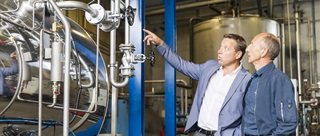
LNG is an effective way to power industry sectors.
Liquefied natural gas (LNG) is a highly versatile fuel.
As LNG can be used for a wide range of industrial applications and processes, such as heating, cooling, drying, processing and food production. It is already widely used in a variety of industries worldwide wherever natural gas isn’t available. Sectors that rely on LNG include food processing, bottling of beverages, pet food manufacture, dairy products manufacture, aggregates and asphalts - to name just a few.
Clean-burning and low carbon, LNG is an effective, tried-and-tested alternative to expensive, oil-based systems for businesses concerned about costs and sustainability.
SHV Energy fully embraces this ethos by setting rigorous safety standards in the installation and commissioning of equipment, driver selection and training, compulsory procedures and documentation.
LNG is often the fuel of choice for businesses in geographically remote locations. These typically include:

Dairy partners
Read how Dairy Partners cut energy costs by 29% and CO2 emissions by 30% when it switched to LNG.
The main components of an LNG plant are a cryogenic tank, an ambient air vaporiser, a compressor unit and an odouriser. LNG is transferred from the tank into the vaporiser where it evaporates through ambient heat and is channeled into the compressor at a controlled temperature and pressure. The LNG is then odourised using an additive to make it easy to detect any leaks for maximum safety. Find out more about LNG
cryogenic tank and pressure build-up unit (PBU)
The LNG is piped to a double-walled, vacuum-insulated tank installed at the customer’s site that acts as their own personal gas reserve. The PBU guarantees a constant pressure level.
Vaporiser system
The product is warmed, transforming it into gas.
Trim heater
If the gas is too cold for delivery, the trim heater will heat it up until it reaches the right temperature.
First stage regulator
Ensures gas is delivered at the correct pressure for the customer.
Odouriser
As a safety measure, an odouriser is added to the colourless and odourless gas as it passes through the vaporisers. This gives it a ‘rotten egg’ smell so that leaks are more easily detected.
Control panel and compressor
The ‘brain’ of the LNG satellite plant, this houses the programmable logic controller (PLC), which manages the safe operation of the plant.
3 Source: Applies to plants with a rated thermal input (RTI) equal to or greater than 1 megawatt (MWth) and less than 50 MWth.
4 Source: When used for power generation, natural gas emits as much as 50 percent less CO2 than coal, results in negligible emissions of sulfur dioxide (SO2), nitrogen oxides (NOx), mercury (Hg), and particulates compared with other fuels - International Gas Union.
5 Source: Handbook of Liquefied Natural Gas 2014Handbook of Liquefied Natural Gas 2014
6 Source: https://www.world-nuclear.org/information-library/facts-and-figures
